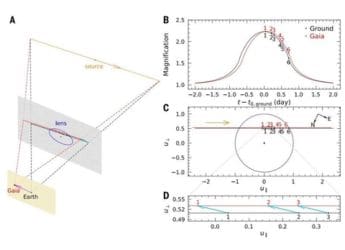- Home
- Science
- Science News
- James Webb Space Telescope Captures Detailed Pictures of Jupiter Showcasing Auroras and Rings
James Webb Space Telescope Captures Detailed Pictures of Jupiter Showcasing Auroras and Rings
The image offers a view of the Great Red Spot, which is a famous and huge storm capable of swallowing Earth.

Photo Credit: NASA, ESA, CSA, Jupiter ERS Team
The image highlights the light reflected from the lower clouds and upper hazes on Jupiter
NASA's James Webb Space Telescope (JWST), hailed as the world's largest and most powerful telescope, has captured some intriguing photos of Jupiter. Apart from powerful winds and giant storms, the new images also feature some magnificent auroras on the gas giant. The pictures offer some intricate details of Jupiter that scientists think may shed more light on its inner life. The Near-Infrared Camera (NIRCam) of the observatory was used to capture the images. With three specialised infrared filters, the instrument delivers detailed data on the planet. However, infrared light isn't visible to the human eye and thus, scientists processed the captured light, bringing it under the visible range.
A standalone picture of Jupiter was produced by stitching together several images from the Webb telescope. It shows the auroras extending to high altitudes of the planet above both the northern and southern poles. The auroras appear bright as they shine in the filter which is mapped to redder colours.
The image also highlights the light reflected from the lower clouds and upper hazes on Jupiter. Hazes are also seen swirling around the northern and southern poles in a different filter, mapped to greens and yellows. Another filter, mapped to blue, shows light reflected from a deeper main cloud. The colours are due to the mapping done by scientists. The longest wavelengths appear redder while the shortest of wavelengths appear blue in the images.
The image also offers a view of the Great Red Spot, which is a famous and huge storm capable of swallowing Earth. The spot and its clouds appear white in the image as they reflect a lot of sunlight.
“The brightness here indicates high altitude — so the Great Red Spot has high-altitude hazes, as does the equatorial region. The numerous bright white ‘spots' and ‘streaks' are likely very high-altitude cloud tops of condensed convective storms,” said Heidi Hammel, Webb interdisciplinary scientist for solar system observations and vice president for science at AURA.
The wide-field view of Jupiter features the faint rings that are a million times fainter than the planet itself. Its two tiny moons, Amalthea and Adrastea, also pop up in the image.
Catch the latest from the Consumer Electronics Show on Gadgets 360, at our CES 2026 hub.
Related Stories
- Samsung Galaxy Unpacked 2025
- ChatGPT
- Redmi Note 14 Pro+
- iPhone 16
- Apple Vision Pro
- Oneplus 12
- OnePlus Nord CE 3 Lite 5G
- iPhone 13
- Xiaomi 14 Pro
- Oppo Find N3
- Tecno Spark Go (2023)
- Realme V30
- Best Phones Under 25000
- Samsung Galaxy S24 Series
- Cryptocurrency
- iQoo 12
- Samsung Galaxy S24 Ultra
- Giottus
- Samsung Galaxy Z Flip 5
- Apple 'Scary Fast'
- Housefull 5
- GoPro Hero 12 Black Review
- Invincible Season 2
- JioGlass
- HD Ready TV
- Laptop Under 50000
- Smartwatch Under 10000
- Latest Mobile Phones
- Compare Phones
- Vivo Y50e 5G
- Vivo Y50s 5G
- Realme 16 Pro+ 5G
- Realme 16 Pro 5G
- TCL Nxtpaper 70 Pro
- OPPO A6 Pro 5G
- Honor Power 2
- OPPO A6s
- Zephyrus Duo 16 (2026)
- Asus ROG Zephyrus G16 (2026)
- Realme Pad 3
- OPPO Pad Air 5
- Xiaomi Watch 5
- Huawei Watch 10th Anniversary Edition
- Acerpure Nitro Z Series 100-inch QLED TV
- Samsung 43 Inch LED Ultra HD (4K) Smart TV (UA43UE81AFULXL)
- Asus ROG Ally
- Nintendo Switch Lite
- Haier 1.6 Ton 5 Star Inverter Split AC (HSU19G-MZAID5BN-INV)
- Haier 1.6 Ton 5 Star Inverter Split AC (HSU19G-MZAIM5BN-INV)

















